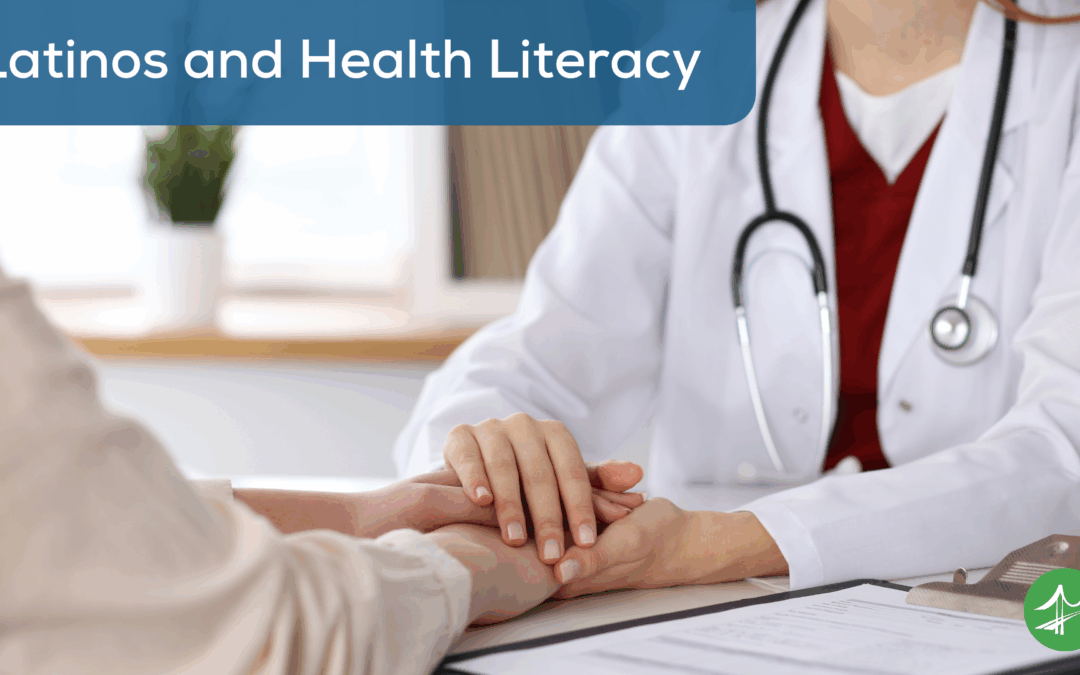One of the overarching goals of Healthy People 2030, a framework designed by the U.S. Department of Health and Human Services’ Office of Disease Prevention and Health Promotion, is to eliminate health disparities and achieve health equity for everyone. In order to do so, it is essential to understand the role health literacy plays in the overall wellbeing of individuals and communities, particularly among populations that are at high risk for poor health.
Latinos are disproportionately susceptible to poor health literacy. According to an assessment by the National Center for Education Statistics, Hispanic adults have the lowest average health literacy scores of all racial/ethnic groups, with 41% considered at “below basic” health literacy levels. Ultimately, this impacts health outcomes–adult Latinos are more likely to suffer from chronic diseases, including obesity and certain types of cancer, according to Families USA. Chronic diseases such as heart disease, cancer, diabetes, and stroke are the leading causes of death for Latinos in America.
Why are Latinos particularly affected by low health literacy rates, how does this impact their overall health, and what can we do to address this issue and improve health outcomes among Latino communities?
Understanding Health Literacy
The Healthy People 2030 framework has recently re-defined health literacy and split it into two parts. Personal health literacy is “the degree to which individuals have the ability to find, understand, and use information and services to inform health-related decisions and actions for themselves and others,” while organizational health literacy is “the degree to which organizations equitably enable individuals to find, understand, and use information and services to inform health-related decisions and actions for themselves and others.” This distinction aims to emphasize people’s ability to apply health information rather than just understand it, and also incorporates a public health perspective that acknowledges the responsibility that organizations have to address health literacy.
While overall literacy rates are certainly correlated with health literacy, the latter also refers to the important role that organizations and the healthcare system as a whole play in increasing patient understanding and safety, which must be a priority.
Disparities in Healthcare
Health literacy falls into one of the key domains of the social determinants of health – health care access and quality. Historically, health disparities relating to access and quality of care have disproportionately affected Latinos in the U.S. There are several factors that can contribute to low health literacy, including poverty, education, and language, all of which make the Latino population susceptible.
Language
Some of the greatest disparities in health literacy are linked to language. According to the Office of Disease Prevention and Health Promotion, 74% of Spanish-speaking patients have less-than-adequate health literacy, compared to 7% of patients whose first language is English, and people with low health literacy and limited English proficiency are twice as likely as individuals without these barriers to report poor health status. Communication barriers between Latino patients and their healthcare providers are complex and go beyond whether patients are English-proficient. For example, miscommunication can be a result of patients having high verbal fluency but low literacy. As a result, providers often have misconceptions about their patients’ comprehension, and thus patients receive written instructions that don’t match their reading level, which can lead to an inability to accurately follow treatment plans.
Education
Naturally, health literacy is closely related to overall education levels. Education is also a key determinant of health, and studies show that higher educational attainment is tied to lower levels of susceptibility to certain diseases such as diabetes and heart ailments, and is linked to improved family and community wellbeing, according to a study on the intersection between health and education by the University of New Mexico. While Hispanics value education–9 out of 10 believe that a college degree is important for getting ahead in life, according to the Pew Research Center, Hispanics in the U.S. have historically experienced high dropout and low college completion rates. Research also shows that Hispanic college students have higher health literacy levels than the general Hispanic population. Thus, interventions focused on improving access to academic opportunities and graduation rates in order to address the education gap for Latinos will be an integral part of improving health literacy rates within the Hispanic community.
Access and Quality of Care
Access to services is another factor that continues to be a major barrier for the Latino population. The International Latino Coalition reports that Latinos often find the U.S. healthcare system difficult to navigate and they feel disconnected from the benefits of coverage and care. Two factors affecting access to care are lack of insurance coverage and not having a routine source of care. Hispanics have the highest uninsured rate of any racial or ethnic group in the United States according to the U.S. Department of Health and Human Services Office of Minority Health, and this is even more severe among Hispanic immigrants. Without insurance, health care in the U.S. is unaffordable for most of the population, and individuals are less likely to have a standard source of care as a result. Beyond cost and coverage, there are numerous other reasons that Latinos lack access to regular care, including a shortage of health centers in their communities, low rates of Hispanic physicians, and fear due to misinformation, harsh immigration policies, and mistreatment within the healthcare system. According to the National Academy of Sciences, more than one-half of Hispanics believe they receive lower quality of care than whites, and 36 percent of Hispanics (compared with 15 percent of whites) reported that they, a family member, or a friend had been treated unfairly by the medical care system because of their race or ethnicity.
The Impact of Health Literacy on Health Outcomes
Limited health literacy is directly correlated with poor health outcomes. Communication barriers with providers, whether due to language, education, or biases, lead to ineffective patient education and thus a decreased likelihood of successfully executed treatment plans. Such communication barriers have even been associated with negative outcomes such as increased likeliness of hospitalization. Inadequate access to services and the absence of a routine source of care result in a lack of continuity in care and increases the likelihood of unaddressed health concerns. For the Latino population, these factors all contribute to negative overall health outcomes within their communities.
Closing the Health Literacy Gap
Latinos represent the fastest growing segment of the U.S. population, however their health outcomes are not improving—which proves to be a major public health issue that must be addressed urgently. So, what can we do to reduce disparities in health status? First, healthcare providers must work to improve communication issues. Low health literacy is common, so when interacting with all patients, providers should simplify communication, and confirm comprehension from their patients. On a systemic level, we must make the healthcare system easier to navigate, provide more sources of affordable care, and increase the number of Spanish-speaking healthcare providers. Additionally, our predominately English-language healthcare system in the U.S. needs to adapt to be more inclusive towards the 39 million Hispanics who speak Spanish at home (Pew Research Center).
Furthermore, we must work to integrate health literacy improvement efforts into general education programs. The National Action Plan to Improve Health Literacy recommends incorporating age-appropriate health curricula from preschool age through university levels and expanding local adult education efforts.
By taking these steps, whether in implementation through your own staff or in collaboration with strategic partners, we can begin to improve the overall wellbeing of Latino communities in the U.S., with the goal of ultimately achieving health equity for all.
Image source: Hand of doctor reassuring her female patien by andrei_r from Getty Images Pro


